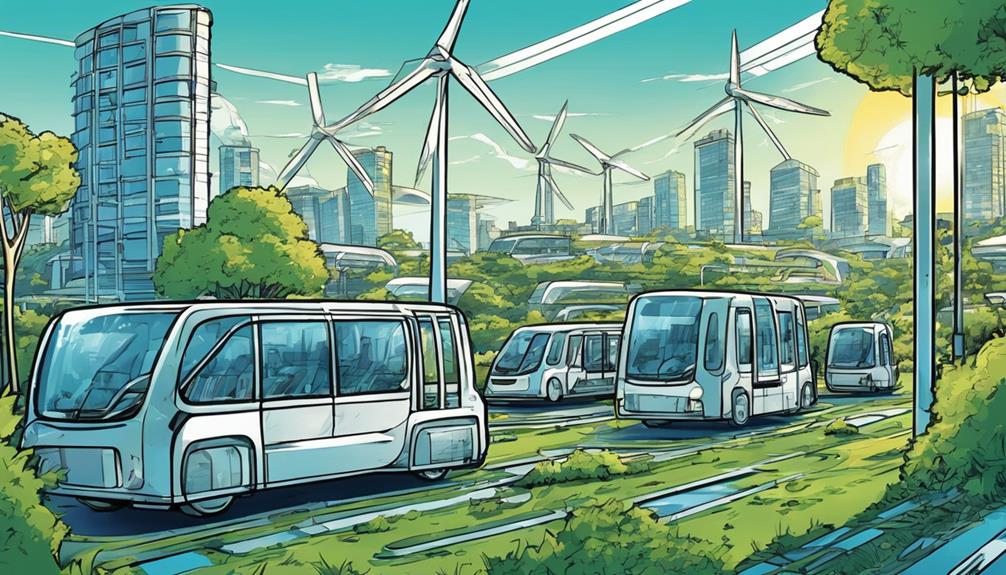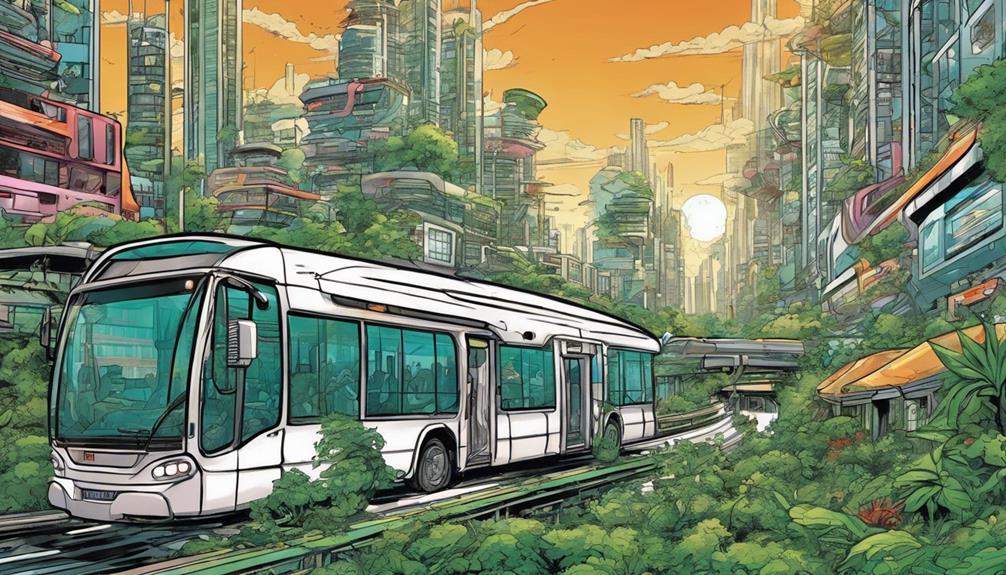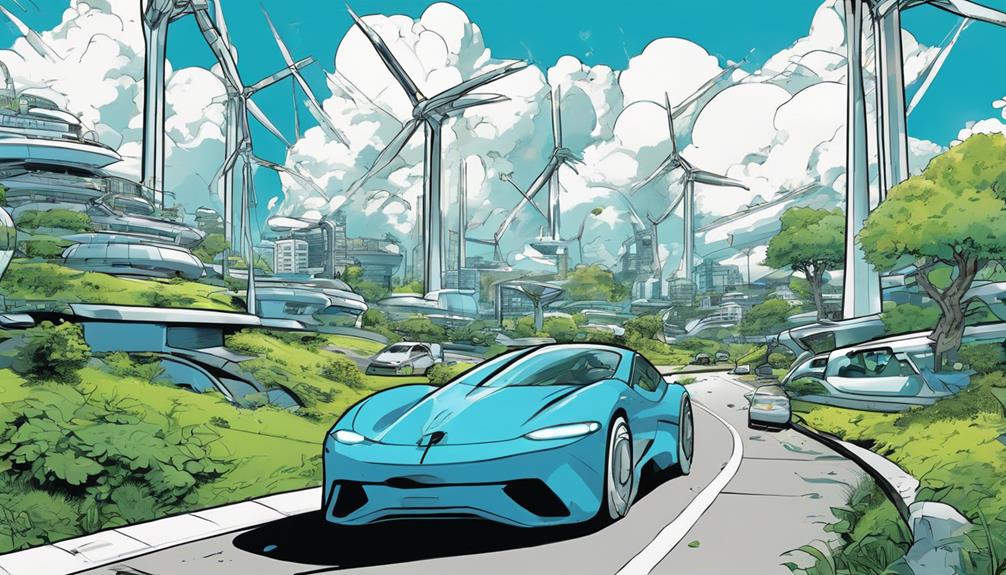I'm thrilled to see the solar revolution transforming the transportation sector. With electric vehicle adoption on the rise, solar power is extending to aviation and maritime transportation, promising a significant reduction in fossil fuel reliance and emissions. While challenges like limited charging stations and high initial costs exist, advancements in infrastructure and policy reforms are addressing these hurdles. As I explore this topic further, I'm discovering innovative solutions that are paving the way for a sustainable transportation future – and I'm enthusiastic to uncover more.
Key Takeaways
- Solar power in transportation reduces fossil fuel use, extending to aviation and maritime sectors, and promotes electric vehicle adoption.
- Expanding solar charging infrastructure, advancing energy storage, and reforming policies are crucial to overcome adoption hurdles.
- Solar-powered public transportation, like buses, lowers operating costs, improves air quality, and enhances sustainability.
- Solar energy in aviation and maritime sectors reduces emissions, relies less on fossil fuels, and promises a more environmentally friendly future.
- Strategic placement and upgrading of solar charging infrastructure are vital for a sustainable transportation revolution.
Solar Power in Transportation

As I hit the road, I'm excited to explore how solar power is revolutionizing the transportation sector, reducing our reliance on fossil fuels and lowering carbon emissions.
Solar-powered vehicles are becoming more efficient and practical, with solar panels on cars converting sunlight into electricity and reducing fossil fuel use.
Solar charging infrastructure is essential, with stations strategically located for reliable power. This clean mode of transport is extending to aviation and maritime transportation, promising a more sustainable future.
With advancements in solar charging technology, electric vehicle adoption is on the rise. I'm thrilled to see how solar power innovations are transforming the transportation landscape, supporting a greener future and contributing to a more sustainable world.
Challenges and Limitations

While solar power is transforming the transportation sector, I'm also aware that several challenges and limitations need to be addressed to fully harness its potential. One major hurdle is the development of efficient charging infrastructure, which is fundamental for widespread adoption. Ensuring seamless grid integration and addressing energy storage challenges are also essential. Additionally, regulatory hurdles and high initial costs require careful planning and coordination.
| Challenge | Impact | Solution |
|---|---|---|
| Limited charging stations | Hindered adoption | Expand and upgrade infrastructure |
| Energy storage | Reduced reliability | Advancements in battery technology |
| Regulatory hurdles | Delayed implementation | Policy reforms and incentives |
| High initial costs | Limited access | Subsidies and financing options |
Solar Public Transportation

Solar-powered buses are revolutionizing public transportation, offering a clean, efficient, and cost-effective alternative that's reducing carbon emissions and improving air quality in urban areas. As I explore the benefits of solar public transportation, I'm excited to see the impact it's having on our daily commutes.
Here are just a few ways solar power is transforming public transportation:
- Reduced Operating Costs: Solar-powered buses require less maintenance and fuel, resulting in lower operating costs for transportation agencies.
- Improved Air Quality: By reducing reliance on fossil fuels, solar-powered buses are decreasing air pollution in urban areas, creating a healthier environment for commuters.
- Enhanced Sustainability: Solar energy is a renewable resource, making solar-powered public transportation a vital step towards a more sustainable future.
Aviation and Maritime Solutions

I'm now exploring how solar power is taking to the skies and seas, transforming aviation and maritime transportation with innovative solutions that promise a more sustainable future.
Solar panels on spacecraft generate electricity for systems in outer space, while solar-powered drones recharge using sunlight for longer flight times. Hybrid solutions combining solar power with other renewables enhance sustainability in these sectors.
By reducing emissions and decreasing reliance on fossil fuels, solar energy is contributing to a greener future in aviation and maritime transportation. These innovations are transforming sustainability in these sectors, promising a more environmentally friendly future for transportation.
As solar power continues to advance, we can expect to see even more exciting developments in aviation and maritime transportation.
Solar Charging Infrastructure

What's holding back the widespread adoption of solar-powered vehicles, and how can we overcome the charging infrastructure challenges that stand in the way of a sustainable transportation revolution?
As I explore the world of solar-powered transportation, I realize that the lack of efficient charging infrastructure is a major hurdle. To address this, we need to focus on:
- Strategic placement: Solar charging stations must be strategically positioned to guarantee reliable power supply.
- Upgrading power grid infrastructure: Our current power grid infrastructure needs to be upgraded to accommodate the influx of solar energy.
- Advancements in charging technology: We need to invest in technological advancements that can accelerate the charging process and make it more efficient.
Economic and Social Impact

As I explore the economic and social implications of solar energy, it becomes clear that access to this sustainable solution isn't equally distributed among all communities.
Economic disparities play a significant role in determining who can benefit from solar power. Low-income communities face significant barriers, including limited access to capital, lack of knowledge, and community engagement challenges.
This means they often can't afford the high upfront costs of solar installations, making it difficult for them to shift to clean energy. It's vital that we address these economic disparities to guarantee equitable access to solar energy.
Overcoming Integration Challenges

As I explore the realm of solar-powered transportation, I realize that overcoming integration challenges is essential for its widespread adoption. Developing efficient charging infrastructure, guaranteeing seamless grid integration, and addressing energy storage challenges are critical steps in overcoming the integration hurdles that stand in the way of widespread solar power adoption in transportation.
To overcome these challenges, we must:
- Upgrade power grid infrastructure to accommodate the influx of solar energy.
- Develop advanced energy storage solutions to guarantee a stable and reliable power supply.
- Implement smart charging systems that optimize energy distribution and reduce strain on the grid.
Sustainable Future Ahead

By embracing solar power in transportation, I'm driving towards a sustainable future where fossil fuels are a relic of the past, and clean energy propels us forward.
As I imagine a world where solar-powered vehicles zip by, I'm excited about the possibilities. With solar charging infrastructure expanding, I'll have the freedom to travel without harming the planet.
Solar-powered public transportation will provide a clean mode of transport, reducing carbon emissions and improving air quality. Even aviation and maritime transportation are embracing solar power, promising a greener future.
As we overcome integration challenges, I'm confident that solar power will revolutionize transportation, making it more sustainable, efficient, and environmentally friendly.
The future is bright, and I'm proud to be a part of it.
Frequently Asked Questions
Can Solar Power Be Used for High-Speed Transportation Modes Like Trains and Bullet Trains?
"I think solar power can be used for high-speed transportation modes like trains and bullet trains by integrating solar panels into the infrastructure, like tracks or stations, to generate electricity and power the trains."
How Does Solar Power Address the Issue of Energy Storage for Transportation?
'As I explore solar power's role in transportation, I realize that addressing energy storage is essential. Solar-powered batteries and advanced charging tech help mitigate range limitations, ensuring a reliable and sustainable energy supply for electric vehicles.'
Are There Any Solar-Powered Transportation Solutions for Rural or Off-Grid Areas?
Yeah, I've come across some innovative solar-powered transportation solutions for rural or off-grid areas, like solar-powered buses and trucks that can recharge using solar panels, making them perfect for areas with limited grid access.
Can Solar Power Be Integrated With Other Renewable Energy Sources for Transportation?
Yeah, I think solar power can definitely be integrated with other renewable energy sources for transportation, like wind or hydro power, to create hybrid solutions that enhance sustainability and reduce emissions even further.
What Is the Projected Timeline for Widespread Adoption of Solar-Powered Transportation?
"As I gaze into the future, I see a horizon where solar-powered transportation becomes the norm – but when? Experts predict widespread adoption by 2040, but I think it'll happen sooner, driven by innovation and growing demand."
How is the logistics industry contributing to the sustainable transportation growth powered by solar revolution?
The logistics industry plays a crucial role in the sustainable transportation growth powered by the solar revolution. By incorporating solar-powered vehicles and sustainable transportation methods, the logistics industry is reducing its carbon footprint and contributing to a greener future. Embracing the logistics industry solar revolution benefits both the environment and the industry’s bottom line.
How Is Solar Power Revolutionizing the Transportation Industry?
The logistics industry solar revolution is reshaping transportation as we know it. With the integration of solar power in vehicles and infrastructure, the transportation industry is becoming more sustainable and cost-effective. From solar-powered cars to electric trucks with rooftop solar panels, the future of transportation is bright thanks to solar power.
Conclusion
As I gaze out at the horizon, I see a transportation landscape transformed by the sun's radiant power. Solar panels unfurl like petals, blanketing roads and waterways, as vehicles hum along, fueled by clean energy.
The future unfolds like a canvas, vibrant with possibility, where sustainability and innovation entwine.
The solar revolution isn't just a dream, but a beacon illuminating the path to a cleaner, brighter tomorrow.










